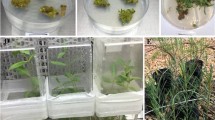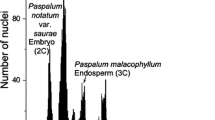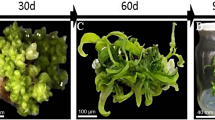Abstract
The genome size of eight species from different wild Algerian populations of diploid and one tetraploid Medicago L., initially analysed for chromosome numbers and seed storage proteins, has been assessed by flow cytometry. Genome size ranged from 2C = 0.94 pg in Medicago orbicularis (L.) Bartal. to 2C = 1.80 pg in Medicago laciniata (L.) Miller. The competence for direct somatic embryo formation in liquid medium was studied for 4 of these species having distinct genome sizes: M. orbicularis (2C = 0.94 pg); M. truncatula Gaertn. (2C = 1.08 pg); M. scutellata (L.) Miller (2C = 1.11 pg); M. arabica (L.) Huds. (2C = 1.22 pg). M. orbicularis, with the smallest genome size, formed somatic embryos most quickly, with a high frequency of reactive explants and with numerous somatic embryos per explant. It was followed by M. truncatula, M. scutellata and M. arabica, which in fact represents the order of increasing genome size.


Similar content being viewed by others
References
Barker DG, Bianchi S, Blondon F, Dattée Y, Duc G, Essad S, Flament P, Gallusci P, Génier G, Guy P, Muel X, Tourneur J, Dénarié J, Huguet T (1990) Medicago truncatula, a model plant for studying the molecular genetics of the Rhizobium-legume symbiosis. Plant Mol Biol Rep 8:40–49
Bauchan GR, Elgin JH (1984) A new chromosome number for the genus Medicago. Crop Sci 24:193–195
Bena G (2001) Molecular phylogeny supports the morphologically based taxonomic transfer of the “Medicagoid” Trigonella species to the genus Medicago L. Plant Syst Evol 229:217–236
Blondon F, Marie D, Brown S, Kondorosi A (1994) Genome size and base composition in Medicago sativa and M. truncatula species. Genome 37:264–270
Brown DSW, Atanassov A (1985) Role of genetic background in somatic embryogenesis in Medicago. Plant Cell Tissue Organ Cult 4:111–122
Catrice O, de la Peña TC, Brown SC (2006) Applications en biologie végétale: contraintes, succès, espoirs. In: Ronot X, Grunwald D, Mayol JF, Boutonnat J (eds) La cytométrie en flux. Tec & Doc - Lavoisier, Paris, pp 235–253
Cook DR (1999) Medicago truncatula—a model in the making! Curr Opin Plant Biol 2:301–304
das Neves LO, Duque SRL, Almeida JS, Fevereiro S (1999) Repetitive somatic embryogenesis in Medicago truncatula ssp narborensis and M. truncatula Gaertn cv. Jemalong. Plant Cell Rep 18:398–405
Denchev P, Velcheva M, Atanassov A (1991) A new approach to direct somatic embryogenesis in Medicago. Plant Cell Rep 10:338–341
Diwan N, Bauchan G, McIntosh M (1994) Medicago scutellata and Medicago rugosa have a natural resistance to the alfalfa weevil: a core collection for the United States annual Medicago germplasm. Crop Sci 34:279–285
Eriksson J, Pfeil B (2012) The phylogeny of Medicago (Fabaceae) using the low copy nuclear gene NORK. Degree project for Bachelor of Science in Systematics and Biosystematics and Biodiversity, Biology. 30 hec. University of Gothenburg
Feulgen R, Rossenbeck H (1924) Mikroskopisch-chemischer Nachweis einer Nukleinsäure vom Typus der Thymonukleinsäure und die darauf beruhende elektive Färbung von Zellkernen in mikroskopischen Präparaten. Hoppe-Seyler’s Z Physiol Chem 135:203–248
Fuentes SI, Suarez R, Villegas T, Acero LC, Hernendez G (1993) Embryogenic response of Mexican alfalfa (Medicago sativa) varieties. Plant Cell Tissue Organ Cult 34:299–302
Fyad-Lamèche FZ (1998) Variabilité des protéines de réserve des graines de populations d’espèces annuelles de Medicago, révélée par SDS-PAGE. Acta Bot Gall 145:199–217
Gamborg OL, Miller RA, Ojima K (1968) Nutrient requirements of suspension cultures of soybean root cells. Exp Cell Res 50:151–158
Hanson AA, Barnes DK, Hill RR (1988) Alfalfa and alfalfa improvement. American Society of Agronomy, Madison
Iantcheva A, Vlahova M, Bakalova E, Kondorosi E, Elliott MC, Atanassov A (1999) Regeneration of diploid annual medics via direct somatic embryogenesis promoted by thidiazuron and benzylaminopurine. Plant Cell Rep 18:904–910
Iantcheva A, Vlahova M, Trinh TH, Brown SC, Slater A, Elliott MC, Atanassov A (2001) Assessment of polysomaty, embryo formation and regeneration in liquid media for various species of diploid annual Medicago. Plant Sci 160:621–627
Iantcheva A, Vlahova M, Atanassov A (2006) Somatic embryogenesis in genera Medicago: an overview. In: Mujib A, Šamaj J (eds) Somatic embryogenesis. Plant Cell Monographs, vol 2. Springer, Berlin, pp 285–304
Iantcheva A, Revalska M, Zehirov G, Vassileva V (2014) Agrobacterium-mediated transformation of Medicago truncatula cell suspension culture provides a system for functional analysis. In Vitro Cell Dev Biol Plant 50:149–157
Johnson LB, Stuteville DL, Higgins RK, Skinner DZ (1981) Regeneration of alfalfa plants from protoplasts of selected Regen-S clones. Plant Sci Lett 20:297–304
Kharrat-Souissi A, Siljak-Yakovlev S, Brown SC, Chaieb M (2013) Cytogeography of Cenchrus ciliaris (Poaceae) in Tunisia. Folia Geobot 48:95–113
Krall JM, Delaney RH, Claypool DA, Groose RW (1996) Evaluation of cold tolerance in annual medics with potential for use in rotation with wheat on the US high plains. Report 35th North American alfalfa improvement Conference, June, Oklahoma City, USA
Krishnaraj S, Vasil IK (1995) Somatic embryogenesis in herbaceous monocots. In: Thorpe TA (ed) In vitro embryogenesis in plants. Kluwer Academic Publishers, Dordrecht, pp 155–203
Laemmli UK (1970) Cleavage of structural proteins during the assembly of the heat of bacteriophage T4. Nature 227:680–685
Lesins KA, Lesins I (1979) Genus Medicago (Leguminosae): a taxogenetic study. W Junk, Boston, p 228
Li XQ, Demarly Y (1995) Characterisation of factors affecting plant regeneration frequency of Medicago lupulina L. Euphytica 86:43–148
Marie D, Brown SC (1993) A cytometric exercise in plant DNA histograms, with 2C values for 70 species. Biol Cell 78:41–51
Maureira-Butler IJ, Pfeil BE, Muangprom A, Osborn TC, Doyle JJ (2008) The reticulate history of Medicago (Fabaceae). Syst Biol 57:466–482
Merkle SA, Parott WA, Flinn BS (1995) Morphogenic aspects of somatic embryogenesis. In: Thorpe TA (ed) In vitro embryogenesis in plants. Kluwer Academic Publishers, Dordrecht, pp 155–203
Murashige T, Skoog F (1962) A revised medium for rapid growth and bioassays with tobacco tissue cultures. Physiol Plant 15:473–497
Ochatt SJ (2008) Flow cytometry in plant breeding. Cytometry 73A:581–598
Ochatt SJ, Patat-Ochatt EM, Djenanne S (2013) Flow cytometric analysis and molecular characterization of Agrobacterium tumefaciens-mediated transformants of Medicago truncatula. Plant Cell Tiss Organ Cult 113:237–244. doi:10.1007/s11240-012-0263-1
Sangwan R, Bourgeois Y, Brown SC, Vasseur G, Sangwan-Norreel B (1992) Characterization of competent cells and early events of Agrobacterium-mediated genetic transformation in Arabidopsis thaliana. Planta 188:439–456
Schmiedernnecht M, Lesins K (1968) Weitere Untersuuchungen zur Resistenz von Medicago-Arten genen Pseudopesiza medicaginis (Lib.). Theor Appl Genet 38:188–194
Singh RJ (2010) Plant cytogenetics, 2nd edn. CRC Press, Boca Raton
Small E (2011) Alfalfa and relatives: evolution and classification of Medicago. NRC Research Press, Ottowa, p 727
Small E, Brookes BS (1990a) A numerical taxonomic analysis of the Medicago littoralis—M. truncatula complex. Can J Bot 68:1667–1674
Small E, Brookes BS (1990b) A taxonomic simplification of Medicago italica. Can J Bot 68:2103–2111
Steele KP, Ickert-Bond SM, Zarre S, Wojciechowski MF (2010) Phylogeny and character evolution in Medicago (Leguminosae): evidence from analyses of plastid TRNK/MATK and nuclear GA3ox1 sequences. Am J Bot 97:1142–1155
Trinh H, Ratet P, Kondorosi E, Durand P, Kamate K, Bauer P, Kondorosi A (1998) Rapid and efficient transformation of diploid Medicago truncatula and Medicago sativa subsp. falcata lines improved in somatic embryogenesis. Plant Cell Rep 17:345–355
Young ND, Udvardi M (2009) Translating Medicago truncatula genomics to crop legumes. Curr Opin Plant Biol 12:193–201. doi:10.1016/j.pbi.2008.11.005
Acknowledgments
The authors thank Odile Robin for her competent assistance in karyology, and M. Labdi Mohamed of Experimental Station (ITGC, Sidi-Bel-Abbès) and M. Abdelguerfi Aissa of INA for plant material. The cytometry was done at Imagif now Institute for Integrative Biology of the Cell CNRS, Gif-sur-Yvette, with the help of Danièle De Nay. A Grant to FL from the International Foundation for Science, Stockholm, was appreciated. Anelia Iantcheva benefitted from a bourse d’excellence of the Agence Universitaire de la Francophonie and published part of this data in her research report on embryogenesis: Iantcheva et al. (2003) Biotechnol Equip 17:44–49.
Author information
Authors and Affiliations
Corresponding author
Rights and permissions
About this article
Cite this article
Fyad-Lameche, FZ., Iantcheva, A., Siljak-Yakovlev, S. et al. Chromosome number, genome size, seed storage protein profile and competence for direct somatic embryo formation in Algerian annual Medicago species. Plant Cell Tiss Organ Cult 124, 531–540 (2016). https://doi.org/10.1007/s11240-015-0912-2
Received:
Accepted:
Published:
Issue Date:
DOI: https://doi.org/10.1007/s11240-015-0912-2




